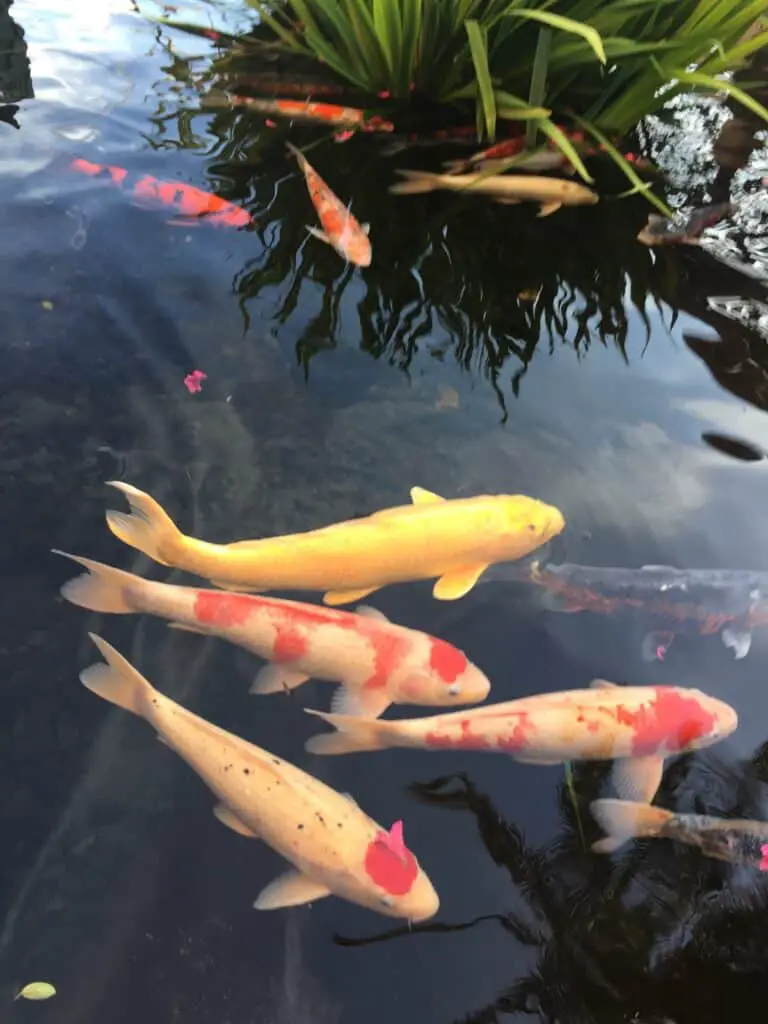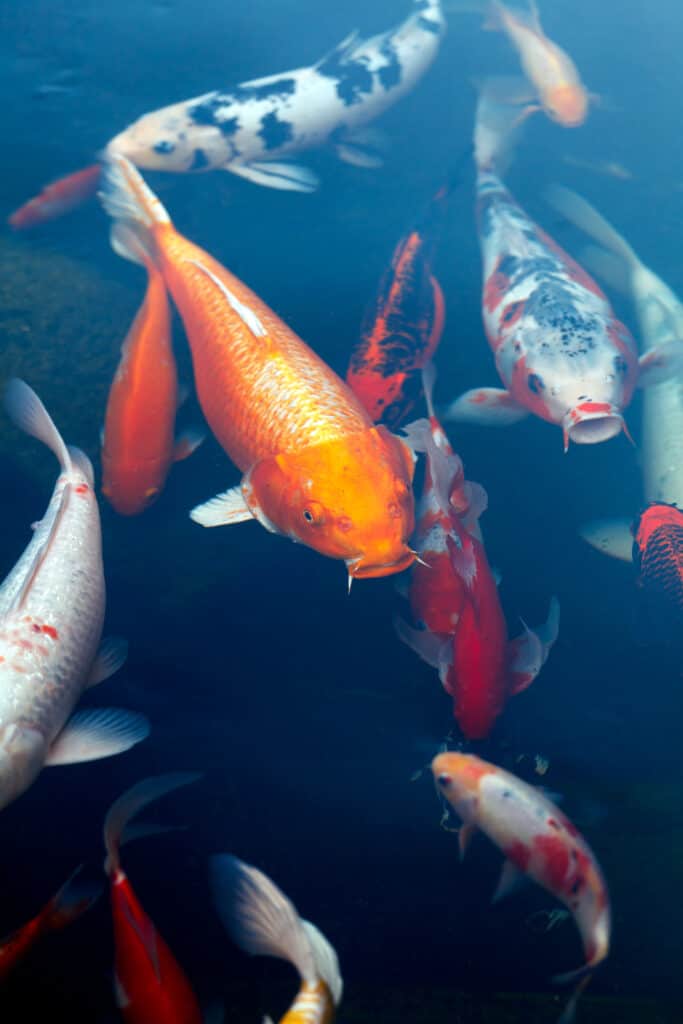
Adding a koi pond into your home environment can become the start of a lifelong hobby involving these fascinating fish species. Even if you don’t intend for it to become a hobby, you are passionate about it, and the koi pond becomes a place of peace and tranquillity where you can relax and collect yourself after a hard day out in the busy world.
Building a Koi pond with blocks is the recommended building material to use. It’s important that you carefully plan the project, making sure that the proposed installation point is suitable and that you will be able to access a grounded electrical connection within easy reach of the pond.
The building process is very simple; however, the more accomplished you are with laying concrete and bricklaying, the better the final result.
Pro Tip: If you’re tired of wasting money and making costly mistakes on the koi-keeping hobby or are thinking about buying koi fish but don’t know where to start, I strongly suggest you check out this ebook. I recently read this ebook, and it contains SO much useful information, such as:
- 3 proven steps to identify koi fish diseases
- WARNING: 3 things you should NEVER do when it comes to caring for koi
- When to seek professional help when it comes to looking after your koi
How To Build A Koi Pond With Concrete Blocks
If you follow a structured plan and complete each step carefully, the result will be a well-constructed pond that can provide a secure and healthy environment for your koi.

Plan The Construction
Decide the purpose of the Koi pond.
- Is it a simple space to display a few koi?
- If a nursery pond for new immature koi.
- Is it a breeding tank?
How ornate or utilitarian do you want it with the above in mind?
Whichever construction material you decide to build your Koi pond from, it is vitally important that you spend time planning every part of it.
It will include a description of the required plumbing, particularly the pipe specifications, routing, and managing the levels.
Ensure there is enough space for the pond and its features (waterfalls etc.), the position of the filter and pump, and how the electrical cabling will be routed.
Ensure the pond is optimally positioned and is not under any trees that may shed leaves and increase the maintenance requirements.
Dig the Pond And Level The Ground
Mark the pond’s outline with any convenient object (hosepipe etc.). Remember that the concrete blocks will be approximately 5,5 inches (140mm) wide, so you must allow for this when digging the pond hole.
The ideal Koi pond size is over 1,000 gallons and at least three feet deep; however, you must dig an optimal depth for your requirements.
Remove the sods of turf within the pond shape.
Having decided what depth of the pond should be below the surface and that which should be above, you can start to dig the hole.
Dig down to the desired depth and level off the pond bottom.
Prepare For Plumbing
Once the hole is at the chosen depth, identify the position of the bottom drain.
Dig out the hole for the center bottom drain and a trench for the piping to connect to the filter.
Install the bottom drain and connect a section of piping long enough to reach out of the pool.
You should use class D and E PVC pressure piping for the pond.
Start Laying The Concrete
Dig a foundation around the pond’s edge and pour a batch of concrete mix, ensuring that the surface is level.
Lay the first course of concrete blocks around the edge (against the dugout pond side).
Add a layer of4 inches of crushed aggregate material onto the base to make it stable. Use a hand tamp to compact the aggregate thoroughly.
Check the floor level and ensure that the lowest part is centered around the bottom drain.
Mix a batch of concrete and lay it around the base of the bottom drain. It will ensure it stays in position when you start laying the floor.
Leave this to cure for 24 hours to make it strong enough to resist the movement as the floor is poured.
There are ready mixed concrete products available with plastic fibers added. These are more suitable for pond construction than traditional steel bars preinstalled at the base.
They are easier to put down and don’t rust, which steel bar is prone to.
They serve the same purpose as rebar reinforcement and should better resist the concrete cracking than the equivalent steel.
Using this material, pour a base that is six inches deep. Ensure the concrete is completely level and the bottom drain is the same height. You don’t want to leave a lip at the bottom drain because debris will collect at this point.
After the base has dried for an hour or two, it is good to float it again and remove any lines and high spots that may have been left when the material was too wet.
Building The Sides
Allow the base to dry and cure for 48 hours.
Using your best bricklaying technique, lay the rest of the concrete blocks to the height, which results in the depth you aim for. As you lay the blocks, offset them, so the ends are staggered and stronger.
When the wall reaches the height of the ground, dig an 8-inch (20cm) wide collar, lay foundation concrete mix In it, and float it until it is completely smooth. It is another layer of belt and braces protection to support the weight of the water and prevent it from being compromised by the lateral forces.
Render the sides with render material, ensuring a smooth finish with no sharp edges or tight corners. Only one coat of render is needed.
The mix of the render material is.
- One part cement.
- Two parts soft sand.
- Twelve pounds (½ Kg) of plastic reinforce fiber mix.
If the “plaster” mix is rendered properly with a steel render tool, the sides will be very smooth and fully waterproof.
When applying the render, try to smooth out corners to prevent algae from forming and spreading.
Allow the render to cure for seven days.
Finish The Build
After the render has fully cured, it is time to coat the walls and floor with waterproof paint.
These are normally sold as a two-part epoxy coat. It is available from any paint store and on Amazon.
The paint must be applied by roller, in even straight application strokes, and then finished on the corners or other tight spaces with a brush.
Once the paint has cured, you can fill the pond with water.
If you have raised part of the pond above the ground level, try to neaten up the appearance by one of the following methods.
- Laying face brick against the exposed concrete blocks
- Render the exposed brick, and when cured, paint it.
- Build up the surrounding ground so the concrete blocks can’t be seen.
- Plant ground cover around the pond will eventually grow up the sides.
Install The Plumbing
Position the filter in your planned spot and root the pipes you pre-positioned to the filter and pump.
The inlet from the bottom drain is connected to the input side of the filter. The outlet is connected by a return pipe which you can neatly root up the side to a waterfall or over the edge back into the pond.
If you intend to install any UV lights or heaters, install them on the outbound, return pipes. Next, you should split the return pipes using a slide drain or ball valve to control the water through the accessories.
The accessory pipe can have its output into the pond.
If you do not have an easily accessed grounded electrical connection, you should contact a fully licensed electrician to install this for you.
When finished, the water has been pumped around for a day, and the temperature is being regulated, you can start introducing the fish.


Conclusion
Building your koi pond is not difficult, particularly if you have basic bricklaying and plastering skills. The result is a place that can become the center of tranquility to take you out of your busy activity and relax for a moment.
If the koi pond is built carefully, with proper planning, and using the appropriate materials, it will require minimal maintenance and be a source of pleasure for years to come.
References
https://www.koicarp.org.uk/koi_pond1.htm
https://homeguides.sfgate.com/build-ponds-concrete-blocks-50107.htmlhttps://www.gardenpondforum.com/threads/ponds-made-of-concrete-blocks.14986/


